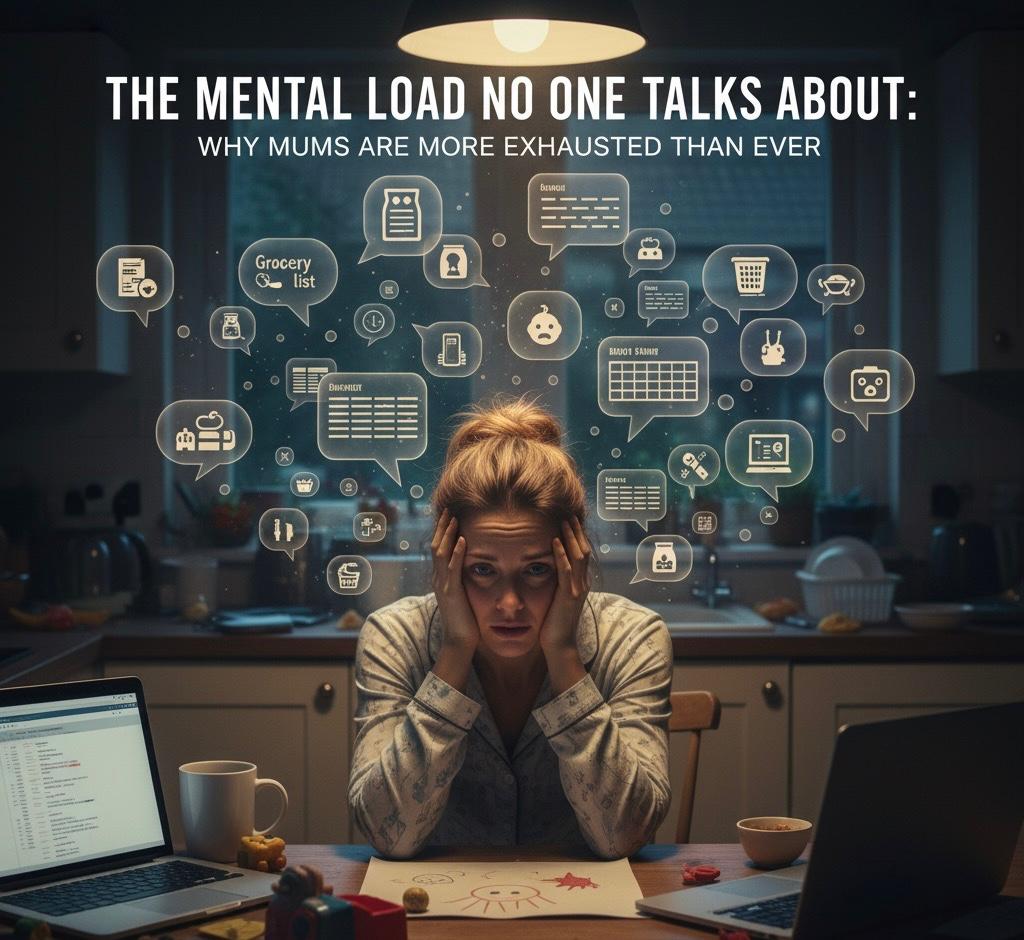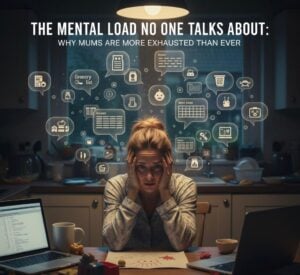Introduction
Many families divide tasks fairly on paper, yet mothers often report feeling permanently “on call”—the default parent, manager, and emotional hub of the household. This invisible strain is the mental load: the ongoing, largely unseen work of remembering, anticipating, coordinating, and worrying so that life runs smoothly (Daminger, 2019). In 2025, digital life, cost‑of‑living pressures, and blurring work–home boundaries have amplified that load, leaving mums more exhausted than ever.
This article examines the mental load through an evidence‑based lens, synthesising findings from time‑use research, cognitive psychology, maternal mental health, and labour economics. We offer practical strategies for partners, employers, and policymakers to redistribute invisible work, support maternal wellbeing, and build healthier, more equitable homes.
1) What is the mental load?
The mental load—also called cognitive labour—includes four recurring processes (Daminger, 2019):
- Anticipation: Noticing what needs to be done (e.g., immunisations are due, the child’s shoes are too small).
- Identification/decision‑making: Choosing options (bookings, brands, budgets).
- Monitoring: Tracking deadlines, supplies, child moods, and calendars.
- Execution coordination: Delegating, arranging, following up so tasks actually happen.
Unlike household chores, cognitive labour is continuous, difficult to outsource, and socially expected of mothers (Craig & Brown, 2017). It consumes working memory and produces decision fatigue, both of which erode mood and performance (Baumeister et al., 2008).
2) Why the mental load disproportionately falls on mums
Cultural scripts and default parenthood
Sociological studies show mothers are still treated as the default parent—the first point of contact for schools, healthcare, and extended family—even when both parents work full‑time (Hochschild & Machung, 2012). Social expectations position mothers as responsible for kin‑keeping (birthdays, playdates, thank‑yous) and emotional labour(soothing, managing conflict) (Erickson, 2005).
Time‑use evidence
Australian and international time‑use surveys find that mothers perform more unpaid care and mental coordinationthan fathers, including at night and on weekends (Craig & Brown, 2017; Bianchi et al., 2012). Even where fathers increase hands‑on care, mothers retain project management and quality control roles (Daminger, 2019).
Sleep and off‑hours responsibility
New mothers lose hundreds of hours of sleep in the first year (Mindell & Lee, 2015). Night waking, infant feeding, and anticipatory anxiety contribute to fragmented sleep, predicting higher depressive symptoms and daytime fatigue (Okun, 2016).
The digital amplifier
School portals, WhatsApp groups, e‑forms, online medical bookings, and perpetual notifications shift administrative work from institutions to parents—usually mothers. This platform‑mediated parenting increases context switching and attentional residue (Leroy, 2009), intensifying cognitive strain.
3) Health consequences: why the load feels like burnout
Cognitive and emotional costs
Chronic invisible work is linked to stress, irritability, sleep problems, and depressive symptoms (Spinola et al., 2020). Continuous monitoring elevates cortisol and keeps the sympathetic nervous system on alert, undermining recovery (Brosschot et al., 2005).
Maternal mental health
Globally, 1 in 7 to 1 in 5 women experience perinatal depression or anxiety (Woody et al., 2017). Perceived inequity at home predicts lower relationship satisfaction and higher depressive symptoms (Ruppanner et al., 2019). The mental load also correlates with parental burnout—emotional exhaustion specific to the parenting role (Mikolajczak et al., 2019).
Physical health spillovers
Decision fatigue and time scarcity reduce exercise, sleep opportunity, and nutritious meal planning, while increasing stress eating and musculoskeletal pain from multitasking (Schieman et al., 2018).
4) Intersectional realities
The mental load is not experienced equally. Single mothers, migrant mums, mothers of children with disabilities, and low‑income families face higher administrative complexity (service forms, funding plans, multiple appointments) with fewer buffers (childcare flexibility, paid leave) (Carney et al., 2021). Neurodivergent mothers (e.g., ADHD, autism) may experience greater executive‑function demands and sensory overload, intensifying exhaustion (Sibley et al., 2021).
5) Workplaces and the “second shift” in 2025
Hybrid work often shifts, not shares, domestic coordination to mothers who are at home more and thus “available” (Ruppanner et al., 2021). Back‑to‑back video calls combined with school logistics, deliveries, and medical admin create role spillover and context collapse—strong predictors of burnout (Edmondson & Lei, 2014).
Yet organisations can mitigate this with flexible scheduling, predictable time off, and manager training to normalise caregiving (Deloitte, 2020). Access to EAP, parental coaching, and return‑to‑work planning reduce attrition among mothers in the mid‑career “leaky pipeline.”
6) Myths that keep the load stuck
- “Mums are just better at multitasking.” Multitasking is largely task‑switching, which reduces accuracy and increases fatigue (Rubinstein et al., 2001).
- “If dads help with chores, the load is equal.” Without sharing planning and monitoring, mothers remain project managers (Daminger, 2019).
- “She’s picky about how things are done (maternal gatekeeping).” Preferences may emerge after repeated failed delegation or social judgment directed at mothers, not fathers (Allen & Hawkins, 1999).
- “Tech makes parenting easier.” It often outsources admin to parents, increasing 24/7 cognitive work.
7) Evidence‑based strategies to lighten the load at home
A. Make the invisible visible
- List recurring cognitive tasks (renewals, birthdays, uniforms, medical). Assign not just execution but planning and monitoring.
- Use shared calendars and task boards with clear ownership and deadlines (Leroy, 2009).
B. Transfer ownership, not tasks
- When delegating, give the other partner full cycle ownership (anticipate → plan → execute → follow‑up). Avoid “manager–assistant” dynamics.
- Accept good‑enough standards to prevent re‑centralising labour.
C. Reduce decision fatigue
- Standardise routines (meal rotations, recurring delivery orders).
- Use default options (pre‑booked check‑ups, subscription refills).
- Create no‑admin windows each evening to down‑regulate arousal.
D. Protect sleep
- Rotate night‑shift parenting and morning logistics.
- Prioritise sleep opportunity of 7–9 hours, especially in the first postpartum year (Okun, 2016).
E. Build community buffers
- Share lifts and after‑school care with other families.
- Pool knowledge (templates for school forms, checklists for travel/illness).
- Consider paid help where possible; it buys recovery time more than convenience.
8) What employers can do
- Predictable flexibility: Offer core‑hours models and protect non‑meeting blocks for school pick‑ups.
- Manager education: Train leaders to plan around school calendars, transitions, and illness spikes.
- Benefits that matter: Backup care days, EAP with parenting support, financial counselling, and return‑to‑work ramp after parental leave (Deloitte, 2020).
- Outcomes over optics: Evaluate performance by outputs, not online presence.
- Measure equity: Track promotion, pay, and attrition by caregiving status to identify structural bottlenecks.
9) Policy levers that reduce the load
- Affordable childcare and early education improve maternal employment and mental health (OECD, 2021).
- Paid parental leave for both parents increases paternal involvement long after leave ends (Duvander & Johansson, 2012).
- Simple, integrated digital services reduce form fatigue for health, disability and education systems (Carney et al., 2021).
10) A compassionate reframing
Mother‑led invisible work is not a personality trait; it is a system outcome produced by norms, institutions, and technology design. Naming the mental load allows families and employers to move from exhaustion and resentmentto design and partnership. The aim is not perfect 50/50 symmetry every day but a fair system where cognitive labour, recovery time, and decision power are shared.
Conclusion
Mums are more exhausted than ever because the modern household runs on cognitive labour that is continuous, undervalued, and disproportionately assigned to mothers. The costs are real: sleep loss, burnout, depressive symptoms, and stalled careers. The solutions are also real: make the invisible visible, transfer full ownership of planning, protect sleep, design employer flexibility, and use policy levers that recognise caregiving as economic infrastructure. With intentional redistribution and supportive systems, families can replace silent overload with shared leadership and sustainable wellbeing.
References
- Allen, S.M. & Hawkins, A.J. (1999) ‘Maternal gatekeeping: Mothers’ beliefs and behaviors that inhibit greater father involvement in family work’, Journal of Marriage and the Family, 61(1), pp. 199–212.
- Baumeister, R.F., Vohs, K.D. & Tice, D.M. (2008) ‘The strength model of self‑control’, Current Directions in Psychological Science, 16(6), pp. 351–355.
- Bianchi, S.M., Sayer, L.C., Milkie, M.A. & Robinson, J.P. (2012) ‘Housework: Who did, does or will do it, and how much does it matter?’, Social Forces, 91(1), pp. 55–63.
- Brosschot, J.F., Gerin, W. & Thayer, J.F. (2005) ‘The perseverative cognition hypothesis: A review of worry, prolonged stress‑related physiological activation, and health’, Journal of Psychosomatic Research, 60(2), pp. 113–124.
- Carney, T., Chalmers, J. & Daya, I. (2021) ‘Supporting people with psychosocial disability in the NDIS: Evidence and experience’, Psychiatry, Psychology and Law, 28(3), pp. 383–400.
- Craig, L. & Brown, J.E. (2017) ‘Feeling rushed: Gendered time pressure and the division of domestic labour’, Social Indicators Research, 132(3), pp. 1161–1185.
- Daminger, A. (2019) ‘The cognitive dimension of household labor’, American Sociological Review, 84(4), pp. 609–633.
- Deloitte (2020) Mental Health and Employers: Refreshing the Case for Investment. London: Deloitte.
- Duvander, A. & Johansson, M. (2012) ‘What are the effects of reforms promoting fathers’ parental leave use?’, Journal of European Social Policy, 22(3), pp. 319–330.
- Edmondson, A. & Lei, Z. (2014) ‘Psychological safety: The history, renaissance, and future of an interpersonal construct’, Annual Review of Organizational Psychology and Organizational Behavior, 1, pp. 23–43.
- Erickson, R.J. (2005) ‘Why emotion work matters: Sex, gender, and the division of household labor’, Journal of Marriage and Family, 67(2), pp. 337–351.
- Hochschild, A.R. & Machung, A. (2012) The Second Shift (rev. ed.). New York: Penguin.
- Leroy, S. (2009) ‘Why is it so hard to do my work? The challenge of attention residue when switching between work tasks’, Organizational Behavior and Human Decision Processes, 109(2), pp. 168–181.
- Mikolajczak, M., Raes, M.-E., Avalosse, H. & Roskam, I. (2019) ‘The role of perceived social support and parental burnout: A longitudinal study’, Journal of Child and Family Studies, 28, pp. 274–287.
- Mindell, J.A. & Lee, C. (2015) ‘Sleep, mood, and development in infants and toddlers’, Sleep Medicine Clinics, 10(4), pp. 549–560.
- OECD (2021) Caregiving and paid work: The distribution of unpaid care work. Paris: OECD Policy Brief.
- Okun, M.L. (2016) ‘Sleep and postpartum depression’, Current Opinion in Psychiatry, 29(6), pp. 461–467.
- Ruppanner, L., Moller, S. & Sayer, L.C. (2019) ‘Expensive childcare and short school days = lower maternal employment and more time in childcare?’, Socius, 5, pp. 1–13.
- Ruppanner, L., Churchill, B. & Scarborough, W.J. (2021) ‘Work from home and the gender gap in work hours during the COVID‑19 pandemic’, Social Science Research, 100, 102653.
- Schieman, S., Badawy, P.J., Ahn, J. & Bierman, A. (2018) ‘Work-life conflict and health’, Annual Review of Sociology, 44, pp. 37–55.
- Sibley, M.H., Coxe, S., Conelea, C. et al. (2021) ‘Executive function in mothers with ADHD: Impacts on parenting’, Journal of Attention Disorders, 25(4), pp. 541–551.
- Spinola, O., Liotti, M., Speranza, A.M. & Tambelli, R. (2020) ‘Caring for infants during COVID-19: A longitudinal study on maternal mental health’, Child: Care, Health and Development, 46(3), pp. 454–462.
- Woody, C.A., Ferrari, A.J., Siskind, D.J., Whiteford, H.A. & Harris, M.G. (2017) ‘Prevalence of perinatal depression: A systematic review and meta‑regression’, Journal of Affective Disorders, 219, pp. 86–92.







